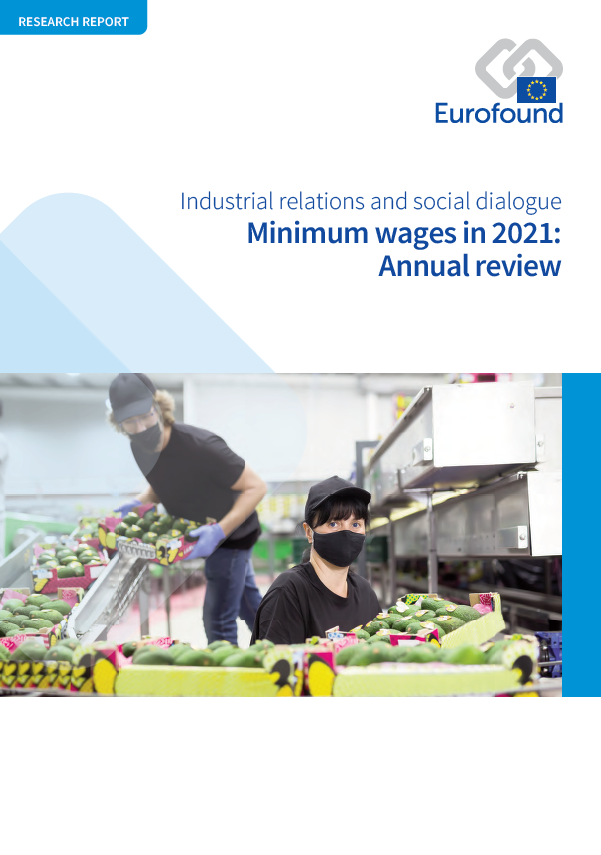Šajā ziņojumā ir apkopots, kā minimālās algas likmes 2021. gadam tika noteiktas 2020. gadā — gadā, ko iezīmēja COVID-19 pandēmija. Tajā ir aplūkotas grūtības, ar kurām saskārās valstu lēmumu pieņēmēji, un tas, kā viņi reaģēja uz pandēmijas ekonomiskā un sociālā krituma problēmām, pieņemot lēmumus par minimālo algu. Tas atspoguļo, cik lielā mērā minimālās algas tika minētas ar COVID-19 saistītajos atbalsta pasākumos. Tajā izklāstītas atziņas, kas gūtas saistībā ar ES iniciatīvu par atbilstošām minimālajām algām, un atspoguļotas ES līmeņa sociālo partneru un valstu lēmumu pieņēmēju reakcijas. Ziņojumam ir pievienoti divi papildu darba dokumenti: vienā sniegta analīze par attīstību attiecībā uz zemu atalgotiem darbiniekiem un minimālās algas saņēmējiem pēdējās desmitgades laikā; otrā apkopoti jaunākie pētījumi par minimālajām algām ES valstīs, Norvēģijā un Apvienotajā Karalistē.
Key findings
No 2020. līdz 2021. gadam lielākajā daļā dalībvalstu minimālās algas tika piesardzīgi paaugstinātas, vidēji valstij sasniedzot 3 % pieaugumu (aprēķināts valstu valūtās). Tikai dažas dalībvalstis nolēma iesaldēt minimālās algas līmeni 2021. gadā. Tas ļoti atšķiras no tā, kā dalībvalstis reaģēja finanšu krīzes laikā.
Valstīs, kurās nav likumā noteiktās minimālās algas (Austrijā, Dānijā, Somijā, Itālijā, Zviedrijā un Norvēģijā), algu pieaugums bija mērens, taču kopumā sarunas izrādījās samērā stabilas. Tā kā dažos gadījumos pandēmija ietekmēja darba koplīguma slēgšanas sarunas, atjaunošana un atalgojuma palielinājums tika atlikts.
Galvenais izaicinājums, ar ko lēmumu pieņēmēji saskārās minimālās algas noteikšanas laikā 2020. gadā, bija vispārējā ekonomiskā nenoteiktība saistībā ar pandēmiju. Ja tika veiktas prognozes, tās bija neskaidrākas vai svārstīgākas nekā parasti.
Sociālo partneru nostāja attiecībā uz ierosināto ES minimālās algas direktīvu paliek nemainīga. Kopumā darba devēju organizācijas ir viskritiskākās un dotu priekšroku nesaistošam ieteikumam. Lielākā daļa arodbiedrību atbalsta šo iniciatīvu, bet vēlas, lai tā virzītos tālāk. Valdību nostājas ir dažādas.
List of tables
The report has the following list of tables:
Table 1: Gross minimum wages, selected EU Member States and the UK, in € and national currencies, 2020 and 2021 compared
Table 2: Sub-minimum rates for selected EU Member States and the UK as of January 2021
Table 3: Occupational or sector-related statutory minimum wage rates in Cyprus, Malta and Romania, January 2021
Table 4: Seniority- or qualification-related top-ups of statutory minimum wage rates for private sector workers, January 2021
Table 5: Minimum wage rates related to level of hardship or job demands for private sector workers, January 2021
Table 6: Change in monthly minimum wages in collective agreements (%), between 1 January 2020 and 1 January 2021, for selected low-paid jobs (national currencies)
Table 7: Minimum wage setting for 2021 – Countries that followed previous commitments
Table 8: Minimum wage setting for 2021 – Countries that adhered to formulas
Table 9: Minimum wage setting for 2021 – Countries that fell short of previous targets
Table 10: Minimum wage setting for 2021 – Countries that opted for cautious increases
Table 11: Minimum wage setting for 2021 – Countries that froze the level or deferred decisions
Table 12: Change in the number of employees 2019 to 2020 and proportion of minimum wage workers, by sector
Table A1: Legal basis for statutory minimum wages
Table A2: Overview of changes to minimum wage regulations in 2020
Table A3: Wage rates in collective agreements related to 10 selected low-paid jobs, 2020 to 2021, in national currency
Table A4: Minimum wage references used in short-time working schemes or for subsidised employment
Table A5: References to the minimum wage determining the eligibility for income support when employed
Table A6: Minimum wage references used to determine the level of COVID-19-related benefits for self-employed people, working parents and others
Table A7: References to the minimum wage determining the eligibility to obtain certain benefits
Table A8: List of other COVID-19 EU PolicyWatch database cases referred to in this report by country
Table A9: Network of Eurofound Correspondents
List of figures
The report has the following list of figures:
Figure 1: Breakdown of national decision-makers interviewed, based on organisation type and system type (%)
Figure 2: Hourly minimum wages (€), selected Member States, 2021
Figure 3: Collectively agreed average or median monthly pay in 10 low-paid jobs, January 2021 (€)
Figure 4: Minimum wage setting for 2021 and the role of the social partners
Figure 5: Change in number of employees between 2019 and 2020 and proportion of minimum wage workers by occupation, men and women
Figure 6: Stances towards the proposed directive by respondent type (%)
Figure 7: Stances towards the proposed directive by type of wage setting (%)
- Number of pages
-
74
- Reference nº
-
EF21015
- ISBN
-
978-92-897-2172-1
- Catalogue nº
-
TJ-AS-21-001-EN-N
- DOI
-
10.2806/47491
- Permalink
Cite this publication
Eurofound (2021), Minimum wages in 2021: Annual review, Minimum wages in the EU series, Publications Office of the European Union, Luxembourg.

